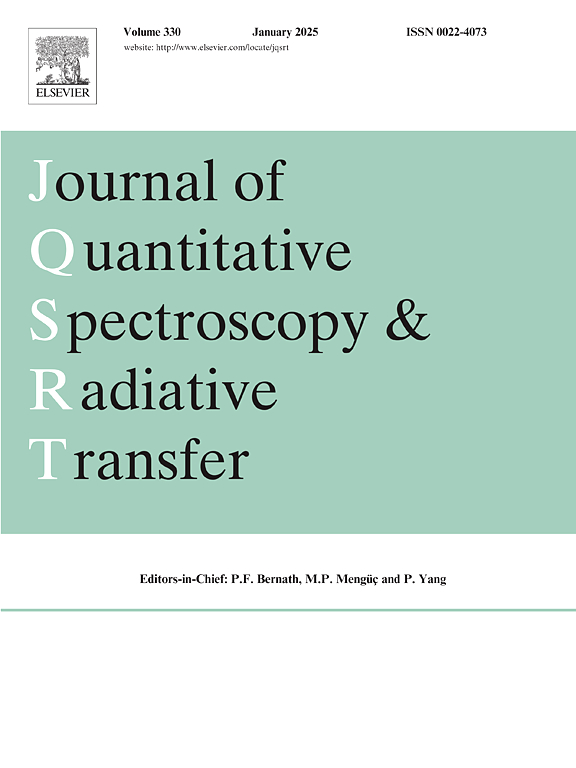改进了对6600-7500 cm−1区域H216O过渡的评估
IF 2.3
3区 物理与天体物理
Q2 OPTICS
Journal of Quantitative Spectroscopy & Radiative Transfer
Pub Date : 2025-05-27
DOI:10.1016/j.jqsrt.2025.109513
引用次数: 0
摘要
由于对水分子中主要同位素(H216O)的旋转振动跃迁和潜在能级进行了大量的实验、经验和计算研究,因此标准逐行光谱数据库HITRAN2020提供的室温覆盖范围几乎是完整的,达到99.87%,最高可达6600 cm−1。本研究提供了两个最新数据集的详细比较,一个是使用双梳光谱仪(DCS)获得的测量线位置和强度数据集,温度高达1300 K,范围从6600到7500 cm−1(忽略了7500 - 7650 cm−1的实验覆盖区域,具有噪声光谱特征),另一个是复合经验线列表,称为CW2024,涵盖了从微波到紫外线的光谱。目的是相互验证两个数据集,纠正它们中可能存在的错误,并提供额外的经过验证的实验数据,以便纳入逐行数据库。最后,研究了DCS测量数据库中的5419个转换与CW2024线列表中的转换,其中大多数线属于两个数据集各自的不确定度。使用复合经验CW2024数据库作为参考,对高温下测量的616条线中的一个子集进行了423次分配,这些线不属于HITRAN2020的一部分。因此,在6600-7500 cm−1区域,除了7个跃迁外,所有的跃迁强度都超过了1×10−28 cm分子−1的室温临界值。在本文的补充材料中,提供了一个更新的DCS数据库,展示了本文中描述的改进。本文章由计算机程序翻译,如有差异,请以英文原文为准。
Improved assessment of H216O transitions in the region 6600–7500 cm−1
Due to the very large number of experimental, empirical, and computational studies addressing the rovibrational transitions and the underlying energy levels of the main isotopologue, HO, of the water molecule, the room-temperature coverage offered by the canonical line-by-line spectroscopic database HITRAN2020 is almost complete, 99.87%, up to 6600 cm. This study provides a detailed comparison of two recent datasets, one with measured line positions and intensities, obtained using a dual-comb spectrometer (DCS), from 6600 to 7500 cm at temperatures up to 1300 K (neglecting the experimentally covered region of 7500–7650 cm with noisy spectral features), and the other a composite empirical line list, called CW2024, covering the spectrum from the microwave to the ultraviolet. The aim has been the mutual validation of the two datasets, correction of possible errors in both of them, and providing additional validated experimental data for inclusion in line-by-line databases. At the end, 5419 transitions from the DCS measurement database were investigated with respect to those in the CW2024 line list, with the majority of the lines falling within the respective individual uncertainties of the two datasets. Using the composite empirical CW2024 database as a reference, 423 assignments were made for a subset of the 616 lines measured at high temperatures which are not part of HITRAN2020. Thus, in the region 6600–7500 cm all but seven transitions, with intensities above a room-temperature cutoff of cm molecule−1, have become experimentally known. In the Supplementary Material to this paper, an updated DCS database is provided, showcasing the improvements described in the article.
求助全文
通过发布文献求助,成功后即可免费获取论文全文。
去求助
来源期刊
CiteScore
5.30
自引率
21.70%
发文量
273
审稿时长
58 days
期刊介绍:
Papers with the following subject areas are suitable for publication in the Journal of Quantitative Spectroscopy and Radiative Transfer:
- Theoretical and experimental aspects of the spectra of atoms, molecules, ions, and plasmas.
- Spectral lineshape studies including models and computational algorithms.
- Atmospheric spectroscopy.
- Theoretical and experimental aspects of light scattering.
- Application of light scattering in particle characterization and remote sensing.
- Application of light scattering in biological sciences and medicine.
- Radiative transfer in absorbing, emitting, and scattering media.
- Radiative transfer in stochastic media.

 求助内容:
求助内容: 应助结果提醒方式:
应助结果提醒方式:


